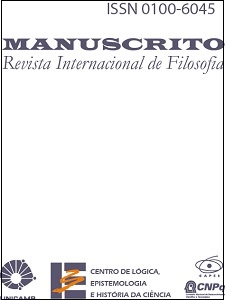Resumen
Hace un tiempo G. Rees señaló la importancia del razonamiento cuantitativo en el programa de la renovación del saber propuesto por F. Bacon, renovando la imagen tradicional de su método. Con la intención de proseguir el replanteo iniciado por Rees de los conceptos centrales del método baconiano, me propongo reexaminar el significado de la experimentación y de los instrumentos científicos, lo cual implica al mismo tiempo considerar la relación entre razón y sentidos. Para ello, examinaré el significado de los sentidos como fuentes del conocimiento, la función de la experimentación y de los instrumentos para superar las limitaciones de los sentidos, la inserción de datos cuantitativos en el marco experimental, el concepto de sutilidad de la naturaleza y el sentido metodológico de la anatomía baconiana. Como conclusión señalo que en el método baconiano los sentidos están subordinados a la razón, ya que tanto los experimentos como los instrumentos científicos están sujetos a la autoridad de la razón para alcanzar la verdad y evitar sus errores.
Citas
BRANDT, R. (1979). “Francis Bacon: Die Idolenlehre” en Grundprobleme der großen Philosophen, hrgs. von J. Speck, (Göttingen: Vandenhoek und Ruprecht), 9-32. COQUILETTE, D. R. (1992). Francis Bacon. (Edinburgh, U.P., Melksham).
CROLL, O. (Crollius). Basilica Chymica continens philosophicam propria laborum experientia confirmatam descriptionem et usum Remediorum Chymicorum. Tractatus novus de Signaturis rerum internis. (Hildesheim/ Zürich/New York, Georg Olms), 1996. Reimpresión de la edición Frankfurt a.M., sin año (ca. 1611).
DEAR, P. (1987). “Jesuit Mathematical Science and the Reconstitution of Experience in the Early Seventeenth Century”, Studies in History and Philosophy of Science, 18(2), 133-175.
————. (1991). “Narratives, Anecdotes, and Experiments: Turning Experience into Science in the Seventeenth Century”, The Literary Structure of Scientific Arguments: Historical Studies, ed. by P. Dear (Philadelphia, University of Pennsylvania Press), p. 135-163.
DEBUS, A.G. (1960). “The Paracelsian Compromise in Elizabethan England”, Ambix, VIII, 2, 71-97.
DIJKSTERHUIS, J.E. (1961). The Mechanization of the World Picture, transl. by C. Diskshoorn. (Oxford, Oxford University Press). Primera ed. Amsterdam: Meulenhoff, 1950.
EAMON, W. (1994). Science and the Secrets of Nature, Books of Secrets in Medieval and Early Modern Culture. (Princeton, New Jersey, Princeton University Press).
FOWLER. Bacon’s Novum Organum, [1878] 1889. Edited and commented by Thomas Fowler. (Oxford, The Clarendon Press).
GEMELLI, B. (1996). Aspetti dell’ Atomismo Classico nella Filosofia di Francis Bacon e nel Seicento. (Firenze, Leo Olschki). HACKING, I. (1983). Representing and Intervening. Introductory Topics in the Philosophy of Natural Science. (Cambridge, Cambridge University Press).
HANNAWAY, O. (1975). The Chemists and the Word: the Didactic Origins of Chemistry. (Baltimore/London, Johns Hopkins University Press).
HESSE, M. (1983). Revolutions and Reconstructions in the Philosophy of Science (Bloomington, Indiana University Press).
HOOYKAAS, R. (1933). The Concept of Element. Its Historical-Philosophical Development, Ph. Diss. Universiteit Utrecht. English translation by C. A. Russell.
JARDINE, L. (1974). Francis Bacon. Discovery and the Art of Discourse. (Cambridge, Cambridge University Press).
————. (1985) “Experientia literata ou Novum Organum? Le delemme de la méthode scientifique de Bacon” en M. Malherbe y J-M.
Pousseur (eds.) Francis Bacon science et méthode. (Paris, Vrin), 135-158.
KLEIN, U. (1997). “Experiment, Spiritus und okkulte Qualitäten in der Philosophie Francis Bacons”, Philosophia Naturalis, 33(2) 289-314.
KUHN, T. (1977). “Mathematical versus Experimental Traditions in the Development of Physical Science” en Kuhn, The Essential Tension. Selected Studies in Scientific tradition and Change. (Chicago, University of Chicago Press), 31-65.
LÜTHY, C. (1996). “Atomism, Lynceus, and the Fate of Seventeenth – Century Microscopy”, Early Science and Medicine; I, 1, 1-27.
MEINEL, C. (1988). “Early Seventeenth-Century Atomism, Theory, Epistemology, and the Insufficiency of Experiment”, Isis, 79, 68- 103. PAGEL, W. (1982). Paracelsus, reedición revisada de la primera edición de 1958. (Basel/New York, Karger).
PARK, C. (1984). “Francis Bacon’s ‘Enchanted Glass’”, Isis, 85, 290- 302.
PÉREZ RAMOS, A. (1988). Francis Bacon’s Idea of Science and the Maker’s Knowledge Tradition. (Oxford, Oxford University Press).
REES, G. (1980). “Atomism and ‘Subtlety’ in Francis Bacon’s Philosophy”, Annals of Science, 37, 549-571.
————. (1985). “Quantitative Reasoning in F. Bacon’s Natural Philosophy”, Nouvelle de la Republique des Lettres, V (1985-I) 27-48.
————. (1986). “Mathematics and Francis Bacon’s Natural Philosophy”, Revue Internationale de Philosophie, 40, 399-426.
————. (1996). “Bacon’s Speculative Philosophy” en Pennolten ed. op.cit., 121-145.
REIF P. (1969). “The Textbook Tradition in Natural Philosophy: 1600- 1650” Journal of the History of Ideas, 30, 30-31.
ROSSI, P. (1990). “La historia de la ciencia y el surgimiento de los problemas” en Las Arañas y las Hormigas. Traducción Juana Bignozzi. (Barcelona, Crítica). Primera edición Bolonia, 1986. El artículo fue publicado por primera vez en A. Di Meo y S.
Tagliagambe (eds.) Scienza e Storia: Analisi Critica e Problema Attuali. (Roma, Riuniti), 1980, 1-26.
————. (1972). “Galileo e Bacone”, en Saggi su Galileo Galilei, Carlo Maccagni (ed.), Publicazioni del Comitato Nazionale per le manifestazioni celebrative del IV centenario della nascita di G.G., Vol. III, Tomo 2, pp. 248-296. (Firenze, G. Barbera Editore).
RÜTTEN, T. (1993). Hippokrates im Gespräch, Selbstverlag der Universitäts-und Landesbibliothek und des Instituts für Theorie und Geschichte der Medizin der Westfälischen WilhemsUniversität Münster, Münster.
SARGENT, R.-M. (1989). “Scientific Experiment and Legal Expertise: the Way of Experience in Seventeenth-Century England”, Studies in History and Philosophy of Science, 20, 19-45.
————. (1994). “Learning from Experience: Boyle’s Construction of an Experimental Philosophy” en Michael Hunter (ed.) Robert Boyle Reconsidered, Cambridge, 57-78.
SHACKELFORD, J. (1998). “Seeds with a Mechanical Purpose. Severinus’s Semina and Seventeenth-Century Matter Theory” en A. C. Debus and Walton (eds.) Reading the Book of Nature, 15-44.
SCHMITT, C. (1969). “Experience and Experiment: a Comparison of Zabarella’a View with Galileo’s De Motu”, Studies in the Renaissance, 16, 80-136.
SEVERINUS PETRUS, Idea Medicinae Philosophicae, Fundamenta continens totius doctrinae Paracelsicae, Hippocraticae, et Galenicae, ad Federicum II. Daniae et Septentrionis Regis, Basileae, 1571.
SHAPIN, S. (1995). A Social History of Truth. Civility and Science in Seventeenth-Century England. (Chicago, Chicago University Press).
URBACH, P. (1987) Francis Bacon’s Philosophy of Science. (La Salle, Illinois, Open Court).

